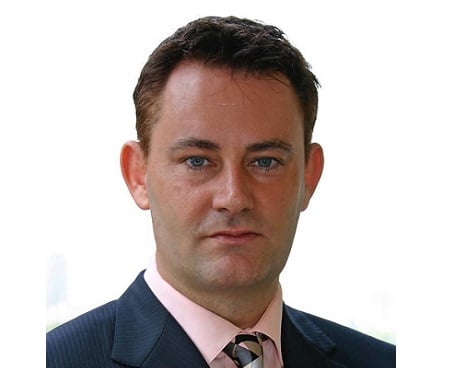

Insurance is global, but it doesn’t mean that a one-size-fits-all works. One such example is the Japanese market, which figures in the eastward shift of economic power.
Paul Atkinson (pictured), country head of Japan at Swiss Re Corporate Solutions, spoke with Insurance Business about the opportunities and challenges faced by the European insurer in Japan, as well as the insurance needs of Japanese businesses expanding overseas.
According to Atkinson, a notable thing about Japan is that despite being the fourth-largest commercial insurance market in the world with total premiums of US$38 billion in 2016, penetration is low compared to other advanced economies.
“For example, commercial insurance penetration in Japan was 0.8% of GDP in 2016, compared to 1.6% in the US and 2.4% in the UK,” he said. “One driver could be that Japan corporates, in general, tend to spend less on insurance and the demand for commercial insurance is sensitive to the economic cycle.
“However, that is only one side of the story. What we see is that while Japanese corporations typically have extremely advanced risk management processes and practices, these are focused on asset protection rather than financial risk and balance sheet protection. We also see the need for more education on the topic of business interruption and non-physical damage business interruption to prevent it being inadvertently underinsured.”
From Atkinson’s perspective, rapid technological progress, particularly digital transformation, is changing the nature of business, and this is where Swiss Re Corporate Solutions sees major opportunities in Japan.
“New types of company and business models, for example, the sharing economy have started to enter the market despite tough regulation and popular suspicion,” he said. “Car and bike sharing schemes are slowly starting to gain traction along with meal delivery services like UberEATS. According to 2018 data published by the Economist, the sharing economy in Japan accounts for US$11 billion, while growing this is still a tiny fraction as compared to developed markets in Europe, the US or China.”
He also mentioned a shift in Japan’s corporate sector from being rich in physical assets to deriving more value from intangibles and services. This is a departure from what Japanese corporates are used to, creating a gap which insurers can fill.
“Over time, the nature of insurable commercial property risks has also broadened from traditional property damage to business interruption and contingent business interruption (CBI), although sales of these covers still lag [behind] European and USA markets,” he said.
“Non-physical damage business interruption (NDBI) is the next step in the evolution of providing solutions for exposures which, traditionally, have been difficult to insure. Data analytics is leading to a better assessment on the nature of risks. This – and the innovation in product design – is driving the continuing development of new risk covers for a wider range of threats and perils that businesses face.”
The risk landscape, according to Atkinson, is constantly evolving as new risks emerge as a result of new technology, globalisation, geopolitical events, and other changes. How companies manage these risks has a great impact on their market value, financial strength, and funding costs.
To illustrate the risks faced by Swiss Re Corporate Insurance in Japan, Atkinson cited a 2017 survey by the World Economic Forum, which revealed that natural catastrophes and cyberattacks are among the top risks cited by Japanese firms, followed by economic risks such as a fiscal crisis.
“Exposed to a wide spectrum of natural disasters, including earthquakes, typhoons, windstorm and floods, it is no surprise that Nat Cat is a top corporate concern,” he said. “A major loss in assets or disruption to production may lead to a reduction in a firm’s share price and even lead to bankruptcy. From a risk management and insurance perspective the widespread nature of Nat Cats creates challenges even with the best business continuity management plans in place.”
He gave the 2011 floods in Thailand as an example, which impacted over 300 Japanese firms.
“During this major ‘wide area damage’ event, critical supply chains were disrupted along with power and utilities, which prevented supplies from reaching their destination,” he said. “As a result, business recovery efforts were substantially delayed, which is not an uncommon occurrence for such events.”
Atkinson also linked business interruption with cyber risks, especially for businesses that possess personal or sensitive data.
“For example, a major auto manufacturer halted its production plant for a day after finding that the WannaCry ransomware had affected the company’s computer network,” he said. “Going even further back, in 2016, there were about 468 cases of cyber incident in Japan and these involved more than 15 million personal information data sets being stolen and estimated losses of ¥299.4 billion.”
As globalisation progresses, Japanese corporations have expanded their interests worldwide, with manufacturing facilities in Europe, the US and many economies in Asia, including China, Thailand, the Philippines, Indonesia and Vietnam. As a result, many Japanese companies are looking for insurance solutions which cater to their operations in multiple jurisdictions.
“As a specific example, the Japanese auto and auto-related sector has a truly global spread,” Atkinson said. “Recalls are happening frequently in this sector and it is becoming more expensive due to longer and more complex supply chains and more stringent product safety rules and regulations. From an infrastructure angle, Japanese investments overseas are on the rise.
“In addition, the Japanese government has recently pledged to make it easier for domestic power companies to invest in overseas power plant projects and with this expected increase, there should be more demand around supply chain business interruption and non-damage business interruption risks.”
